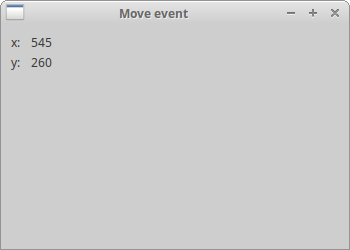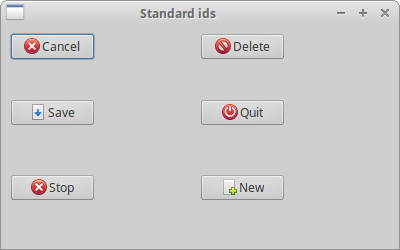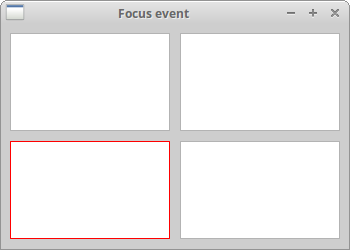Events in wxPython
Events are integral part of every GUI application. All GUI applications are event-driven. An application reacts to different event types which are generated during its life. Events are generated mainly by the user of an application. But they can be generated by other means as well. e.g. internet connection, window manager, timer. So when we call MainLoop() method, our application waits for events to be generated. The MainLoop() method ends when we exit the application.Definitions
Event is a piece of application-level information from the underlying framework, typically the GUI toolkit. Event loop is a programming construct that waits for and dispatches events or messages in a program. The event loop repeatedly looks for events to process. A dispatcher is a process which maps events to event handlers. Event handlers are methods that react to events.Event object is an object associated with the event. It is usually a window. Event type is a unique event, that has been generated. Event binder is an object, that binds an event type with an event handler.
A simple event example
In the following section we will describe a simple event. We will talk about a move event.A move event is generated, when we move a window to a new position. The event type is wx.MoveEvent. The event binder for this event is wx.EVT_MOVE
#!/usr/bin/pythonThe example displays the current position of the window.
# -*- coding: utf-8 -*-
import wx
class Example(wx.Frame):
def __init__(self, *args, **kw):
super(Example, self).__init__(*args, **kw)
self.InitUI()
def InitUI(self):
wx.StaticText(self, label='x:', pos=(10,10))
wx.StaticText(self, label='y:', pos=(10,30))
self.st1 = wx.StaticText(self, label='', pos=(30, 10))
self.st2 = wx.StaticText(self, label='', pos=(30, 30))
self.Bind(wx.EVT_MOVE, self.OnMove)
self.SetSize((250, 180))
self.SetTitle('Move event')
self.Centre()
self.Show(True)
def OnMove(self, e):
x, y = e.GetPosition()
self.st1.SetLabel(str(x))
self.st2.SetLabel(str(y))
def main():
ex = wx.App()
Example(None)
ex.MainLoop()
if __name__ == '__main__':
main()
self.Bind(wx.EVT_MOVE, self.OnMove)Here we bind the
wx.EVT_MOVE event binder to the OnMove() method. def OnMove(self, e):The event parameter in the
x, y = e.GetPosition()
self.st1.SetLabel(str(x))
self.st2.SetLabel(str(y))
OnMove() method is an object specific to a particular event type. In our case it is the instance of a wx.MoveEvent class. This object holds information about the event. For example the Event object or the position of the window. In our case the Event object is the wx.Frame widget. We can find out the current position by calling the GetPosition() method of the event. 
Figure: Move event
Event binding
Working with events is straightforward in wxPython. There are three steps:- Identify the event binder name: wx.EVT_SIZE, wx.EVT_CLOSE etc
- Create an event handler. It is a method, that is called, when an event is generated
- Bind an event to an event handler.
Bind(event, handler, source=None, id=wx.ID_ANY, id2=wx.ID_ANY)
- event is one of EVT_* objects. It specifies the type of the event.
- handler is an object to be called. In other words, it is a method, that a programmer binds to an event.
- source parameter is used when we want to differentiate between the same event type from different widgets.
- id parameter is used, when we have multiple buttons, menu items etc. The id is used to differentiate among them.
- id2 is used when it is desirable to bind a handler to a range of ids, such as with EVT_MENU_RANGE.
Vetoing events
Sometimes we need to stop processing an event. To do this, we call the method Veto().#!/usr/bin/pythonIn our example, we process a
# -*- coding: utf-8 -*-
import wx
class Example(wx.Frame):
def __init__(self, *args, **kw):
super(Example, self).__init__(*args, **kw)
self.InitUI()
def InitUI(self):
self.Bind(wx.EVT_CLOSE, self.OnCloseWindow)
self.SetTitle('Event veto')
self.Centre()
self.Show(True)
def OnCloseWindow(self, e):
dial = wx.MessageDialog(None, 'Are you sure to quit?', 'Question',
wx.YES_NO | wx.NO_DEFAULT | wx.ICON_QUESTION)
ret = dial.ShowModal()
if ret == wx.ID_YES:
self.Destroy()
else:
e.Veto()
def main():
ex = wx.App()
Example(None)
ex.MainLoop()
if __name__ == '__main__':
main()
wx.CloseEvent. This event is called, when we click the X button on the titlebar, press Alt + F4 or select close from the system menu. In many applications, we want to prevent from accidentally closing the window, if we made some changes. To do this, we must bind the wx.EVT_CLOSE event binder. dial = wx.MessageDialog(None, 'Are you sure to quit?', 'Question',During the processing of the close event, we show a message dialog.
wx.YES_NO | wx.NO_DEFAULT | wx.ICON_QUESTION)
ret = dial.ShowModal()
if ret == wx.ID_YES:Depending on the return value from the dialog, we destroy the window, or veto the event. Notice that to close the window, we must call the
self.Destroy()
else:
event.Veto()
Destroy() method. By calling the Close() method, we would end up in an endless cycle. Event propagation
There are two types of events. Basic events and command events. They differ in propagation. Event propagation is travelling of events from child widgets to parent widgets and grand parent widgets etc. Basic events do not propagate. Command events do propagate. For examplewx.CloseEvent is a basic event. It does not make sense for this event to propagate to parent widgets. By default, the event that is catched in a event handler stops propagating. To continue propagation, we must call the
Skip() method. #!/usr/bin/pythonIn our example, we have a button on a panel. The panel is placed in a frame widget. We define a handler for all widgets.
# -*- coding: utf-8 -*-
import wx
class MyPanel(wx.Panel):
def __init__(self, *args, **kw):
super(MyPanel, self).__init__(*args, **kw)
self.Bind(wx.EVT_BUTTON, self.OnButtonClicked)
def OnButtonClicked(self, e):
print 'event reached panel class'
e.Skip()
class MyButton(wx.Button):
def __init__(self, *args, **kw):
super(MyButton, self).__init__(*args, **kw)
self.Bind(wx.EVT_BUTTON, self.OnButtonClicked)
def OnButtonClicked(self, e):
print 'event reached button class'
e.Skip()
class Example(wx.Frame):
def __init__(self, *args, **kw):
super(Example, self).__init__(*args, **kw)
self.InitUI()
def InitUI(self):
mpnl = MyPanel(self)
MyButton(mpnl, label='Ok', pos=(15, 15))
self.Bind(wx.EVT_BUTTON, self.OnButtonClicked)
self.SetTitle('Propagate event')
self.Centre()
self.Show(True)
def OnButtonClicked(self, e):
print 'event reached frame class'
e.Skip()
def main():
ex = wx.App()
Example(None)
ex.MainLoop()
if __name__ == '__main__':
main()
def OnButtonClicked(self, e):We process the button click event in our custom button class. The
print 'event reached button class'
e.Skip()
Skip() method propagates the event further to to panel class. event reached button classWe get this, when we click on the button. The event travels from the button to the panel and to the frame.
event reached panel class
event reached frame class
Try to omit some Skip() methods and see, what hapens.
Window identifiers
Window identifiers are integers that uniquely determine the window identity in the event system. There are three ways to create window id's.- let the system automatically create an id
- use standard identifiers
- create your own id
wx.Button(parent, -1)If we provide -1 or wx.ID_ANY for the id parameter, we let the wxPython automatically create an id for us. The automatically created id's are always negative, whereas user specified id's must always be positive. We usually use this option when we do not need to change the widget state. For example a static text, that will never be changed during the life of the application. We can still get the id, if we want. There is a method
wx.Button(parent, wx.ID_ANY)
GetId(), which will determine the id for us. #!/usr/bin/pythonIn this example, we do not care about the actual id value.
# -*- coding: utf-8 -*-
import wx
class Example(wx.Frame):
def __init__(self, *args, **kw):
super(Example, self).__init__(*args, **kw)
self.InitUI()
def InitUI(self):
pnl = wx.Panel(self)
exitButton = wx.Button(pnl, wx.ID_ANY, 'Exit', (10, 10))
self.Bind(wx.EVT_BUTTON, self.OnExit, id=exitButton.GetId())
self.SetTitle("Automatic id")
self.Centre()
self.Show(True)
def OnExit(self, event):
self.Close()
def main():
ex = wx.App()
Example(None)
ex.MainLoop()
if __name__ == '__main__':
main()
self.Bind(wx.EVT_BUTTON, self.OnExit, id=exitButton.GetId())We get the automatically generated id by calling the
GetId() method. It is recommended to use standard identifiers. The identifiers can provide some standard graphics or behaviour on some platforms.
#!/usr/bin/pythonIn our example we use standard identifiers on buttons. On Linux, the buttons have icons.
# -*- coding: utf-8 -*-
import wx
class Example(wx.Frame):
def __init__(self, *args, **kw):
super(Example, self).__init__(*args, **kw)
self.InitUI()
def InitUI(self):
pnl = wx.Panel(self)
grid = wx.GridSizer(3, 2)
grid.AddMany([(wx.Button(pnl, wx.ID_CANCEL), 0, wx.TOP | wx.LEFT, 9),
(wx.Button(pnl, wx.ID_DELETE), 0, wx.TOP, 9),
(wx.Button(pnl, wx.ID_SAVE), 0, wx.LEFT, 9),
(wx.Button(pnl, wx.ID_EXIT)),
(wx.Button(pnl, wx.ID_STOP), 0, wx.LEFT, 9),
(wx.Button(pnl, wx.ID_NEW))])
self.Bind(wx.EVT_BUTTON, self.OnQuitApp, id=wx.ID_EXIT)
pnl.SetSizer(grid)
self.SetSize((220, 180))
self.SetTitle("Standard ids")
self.Centre()
self.Show(True)
def OnQuitApp(self, event):
self.Close()
def main():
ex = wx.App()
Example(None)
ex.MainLoop()
if __name__ == '__main__':
main()
grid.AddMany([(wx.Button(pnl, wx.ID_CANCEL), 0, wx.TOP | wx.LEFT, 9),We add six buttons to a grid sizer. The wx.ID_CANCEL, wx.ID_DELETE, wx.ID_SAVE, wx.ID_EXIT, wx.ID_STOP and wx.ID_NEW are standard identifiers.
(wx.Button(pnl, wx.ID_DELETE), 0, wx.TOP, 9),
(wx.Button(pnl, wx.ID_SAVE), 0, wx.LEFT, 9),
(wx.Button(pnl, wx.ID_EXIT)),
(wx.Button(pnl, wx.ID_STOP), 0, wx.LEFT, 9),
(wx.Button(pnl, wx.ID_NEW))])
self.Bind(wx.EVT_BUTTON, self.OnQuitApp, id=wx.ID_EXIT)We bind the button click event to the OnQuitApp() event handler. The id parameter is used to differantiate among the buttons. We uniquely identify the source of the event.

Figure: Standard identifiers
The last option is to use own identifiers. We define our own global ids.
#!/usr/bin/pythonIn the code example, we create a menu with three menu items. The ids for this menu items are created globally.
# -*- coding: utf-8 -*-
import wx
ID_MENU_NEW = wx.NewId()
ID_MENU_OPEN = wx.NewId()
ID_MENU_SAVE = wx.NewId()
class Example(wx.Frame):
def __init__(self, *args, **kw):
super(Example, self).__init__(*args, **kw)
self.InitUI()
def InitUI(self):
self.CreateMenuBar()
self.CreateStatusBar()
self.SetSize((250, 180))
self.SetTitle('Global ids')
self.Centre()
self.Show(True)
def CreateMenuBar(self):
mb = wx.MenuBar()
fMenu = wx.Menu()
fMenu.Append(ID_MENU_NEW, 'New')
fMenu.Append(ID_MENU_OPEN, 'Open')
fMenu.Append(ID_MENU_SAVE, 'Save')
mb.Append(fMenu, '&File')
self.SetMenuBar(mb)
self.Bind(wx.EVT_MENU, self.DisplayMessage, id=ID_MENU_NEW)
self.Bind(wx.EVT_MENU, self.DisplayMessage, id=ID_MENU_OPEN)
self.Bind(wx.EVT_MENU, self.DisplayMessage, id=ID_MENU_SAVE)
def DisplayMessage(self, e):
sb = self.GetStatusBar()
eid = e.GetId()
if eid == ID_MENU_NEW:
msg = 'New menu item selected'
elif eid == ID_MENU_OPEN:
msg = 'Open menu item selected'
elif eid == ID_MENU_SAVE:
msg = 'Save menu item selected'
sb.SetStatusText(msg)
def main():
ex = wx.App()
Example(None)
ex.MainLoop()
if __name__ == '__main__':
main()
ID_MENU_NEW = wx.NewId()The
ID_MENU_OPEN = wx.NewId()
ID_MENU_SAVE = wx.NewId()
wx.NewId() method creates a new unique id. self.Bind(wx.EVT_MENU, self.DisplayMessage, id=ID_MENU_NEW)All three menu items are identified by their unique id.
self.Bind(wx.EVT_MENU, self.DisplayMessage, id=ID_MENU_OPEN)
self.Bind(wx.EVT_MENU, self.DisplayMessage, id=ID_MENU_SAVE)
eid = e.GetId()From the event object we retrieve the id. Depending on the id value, we prepare the message, which is displayed in the statusbar of the application.
if eid == ID_MENU_NEW:
msg = 'New menu item selected'
elif eid == ID_MENU_OPEN:
msg = 'Open menu item selected'
elif eid == ID_MENU_SAVE:
msg = 'Save menu item selected'
PaintEvent
A paint event is generated when a window is redrawn. This happens when we resize a window or when we maximize it. A paint event can be generated programatically as well. For example, when we call SetLabel() method to change awx.StaticText widget. Note that when we minimize a window, no paint event is generated. #!/usr/bin/pythonIn our example we count the number of paint events and set the current number of generated events to the title of the frame window.
# -*- coding: utf-8 -*-
import wx
class Example(wx.Frame):
def __init__(self, *args, **kw):
super(Example, self).__init__(*args, **kw)
self.InitUI()
def InitUI(self):
self.count = 0
self.Bind(wx.EVT_PAINT, self.OnPaint)
self.SetSize((250, 180))
self.Centre()
self.Show(True)
def OnPaint(self, e):
self.count += 1
self.SetTitle(str(self.count))
def main():
ex = wx.App()
Example(None)
ex.MainLoop()
if __name__ == '__main__':
main()
self.Bind(wx.EVT_PAINT, self.OnPaint)We bind the EVT_PAINT event to the OnPaint() method.
def OnPaint(self, e):Inside the OnPaint() event, we increase the counter and set it to the title of the frame window.
self.count += 1
self.SetTitle(str(self.count))
Focus event
The focus indicates the currently selected widget in application. The text entered from the keyboard or pasted from the clipboard is sent to the widget, which has the focus. There are two event types concerning focus. Thewx.EVT_SET_FOCUSevent, which is generated when a widget receives focus. The wx.EVT_KILL_FOCUS is generated, when the widget looses focus. The focus is changed by clicking or by a keybord key. Usually Tab/Shift+Tab. #!/usr/bin/pythonIn our example, we have four panels. The panel with focus is highlighted.
# -*- coding: utf-8 -*-
import wx
class MyWindow(wx.Panel):
def __init__(self, parent):
super(MyWindow, self).__init__(parent)
self.color = '#b3b3b3'
self.Bind(wx.EVT_PAINT, self.OnPaint)
self.Bind(wx.EVT_SIZE, self.OnSize)
self.Bind(wx.EVT_SET_FOCUS, self.OnSetFocus)
self.Bind(wx.EVT_KILL_FOCUS, self.OnKillFocus)
def OnPaint(self, e):
dc = wx.PaintDC(self)
dc.SetPen(wx.Pen(self.color))
x, y = self.GetSize()
dc.DrawRectangle(0, 0, x, y)
def OnSize(self, e):
self.Refresh()
def OnSetFocus(self, e):
self.color = '#0099f7'
self.Refresh()
def OnKillFocus(self, e):
self.color = '#b3b3b3'
self.Refresh()
class Example(wx.Frame):
def __init__(self, *args, **kw):
super(Example, self).__init__(*args, **kw)
self.InitUI()
def InitUI(self):
grid = wx.GridSizer(2, 2, 10, 10)
grid.AddMany([(MyWindow(self), 0, wx.EXPAND|wx.TOP|wx.LEFT, 9),
(MyWindow(self), 0, wx.EXPAND|wx.TOP|wx.RIGHT, 9),
(MyWindow(self), 0, wx.EXPAND|wx.BOTTOM|wx.LEFT, 9),
(MyWindow(self), 0, wx.EXPAND|wx.BOTTOM|wx.RIGHT, 9)])
self.SetSizer(grid)
self.SetSize((350, 250))
self.SetTitle('Focus event')
self.Centre()
self.Show(True)
def OnMove(self, e):
print e.GetEventObject()
x, y = e.GetPosition()
self.st1.SetLabel(str(x))
self.st2.SetLabel(str(y))
def main():
ex = wx.App()
Example(None)
ex.MainLoop()
if __name__ == '__main__':
main()
self.Bind(wx.EVT_SET_FOCUS, self.OnSetFocus)We bind two focus events to event handlers.
self.Bind(wx.EVT_KILL_FOCUS, self.OnKillFocus)
def OnPaint(self, e):In the OnPaint() method, we draw on the windows. The color of the outline depends on whether the window has focus or not. The outline of the focused window is drawn in blue color.
dc = wx.PaintDC(self)
dc.SetPen(wx.Pen(self.color))
x, y = self.GetSize()
dc.DrawRectangle(0, 0, x, y)
def OnSetFocus(self, e):In the OnSetFocus() method, we set the self.color variable to some blue color. We refresh the frame window which will generate a paint event for all its child widgets. The windows are redrawn and the one with the focus has a new color for its outline.
self.color = '#0099f7'
self.Refresh()

Figure: Focus event
KeyEvent
When we press a key on our keyboard, wx.KeyEvent is generated. This event is sent to the widget that has currently focus. There are three different key handlers:- wx.EVT_KEY_DOWN
- wx.EVT_KEY_UP
- wx.EVT_CHAR
#!/usr/bin/pythonIn this example, we process the Esc key press. A message box is shown to confirm, whether we really want to close the application.
# -*- coding: utf-8 -*-
import wx
class Example(wx.Frame):
def __init__(self, *args, **kw):
super(Example, self).__init__(*args, **kw)
self.InitUI()
def InitUI(self):
pnl = wx.Panel(self)
pnl.Bind(wx.EVT_KEY_DOWN, self.OnKeyDown)
pnl.SetFocus()
self.SetSize((250, 180))
self.SetTitle('Key event')
self.Centre()
self.Show(True)
def OnKeyDown(self, e):
key = e.GetKeyCode()
if key == wx.WXK_ESCAPE:
ret = wx.MessageBox('Are you sure to quit?', 'Question',
wx.YES_NO | wx.NO_DEFAULT, self)
if ret == wx.YES:
self.Close()
def main():
ex = wx.App()
Example(None)
ex.MainLoop()
if __name__ == '__main__':
main()
pnl.Bind(wx.EVT_KEY_DOWN, self.OnKeyDown)We bind an event handler to the EVT_KEY_DOWN event.
key = e.GetKeyCode()Here we get the key code of the pressed key.
if key == wx.WXK_ESCAPE:We check the key code. The Esc key has
wx.WXK_ESCAPE code. In this chapter, we talked about events in wxPython.
No comments:
Post a Comment